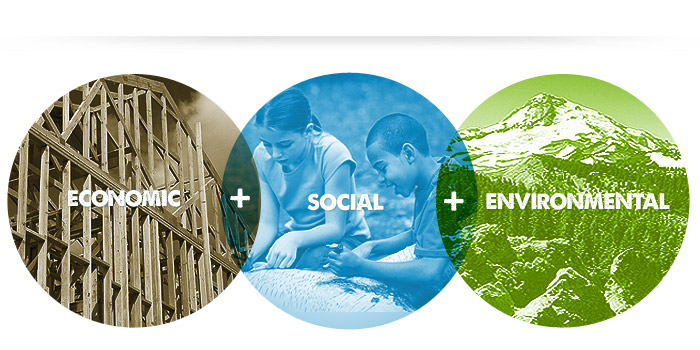
The World Commission on Environment and Development defines sustainable development as “development that meets the needs of the present without compromising the ability of future generations to meet their own needs.”
Our forests are an amazing resource. Wood from sustainably grown trees is renewable and recyclable, and is the primary element in thousands of products we use every day. Through responsible forest management and protective laws, Oregon has maintained our forestland for decades, while at the same time supplying the world with this remarkable and sustainable material. But achieving this careful balance is hard work. Pressure to convert our forestland to other uses is great – and mounting every day.
To some, protecting the forests means taking a “hands-off” approach. But in reality, part of protecting Oregon’s forests includes responsible forest management. This management not only decreases fire risks and increases forest health, but also supports the balance needed for all Oregonians – now and in the future.
It takes collaborative support from the public, landowner and legislature to have it all: a thriving forest sector economy, a recreational playground and healthy forest ecosystems.

Managing Oregon’s forests
With generations of forest management and harvesting experience, we’ve learned that it’s not always best to simply walk away from a forest and let nature take its course. Most forests, especially those near populated areas, need some form of management to ensure their health and sustainability. In cases of forests designated as wilderness, roadless or wild and scenic, the active management may be considerably less involved.
Oregon’s forests are not all managed in the same way. Generally, they fall into one of three management classifications, each accounting for about a third of the state’s forestland:
Wood production
Forests managed mostly for income or timber production by large and small private landowners or tribes, in accordance with Oregon’s forest protection laws. Private forests supply about three-quarters of the annual statewide timber harvest.
Reserve
Forests managed and conserved mostly for environmental and cultural reasons, with limited timber harvest. These forests are largely owned by the federal government and may be set aside as parks or wilderness areas, or as riparian, old-growth or endangered species habitat.
Multi-resource
Forests managed for multiple uses, including recreation, water, wildlife habitat and timber production. These forestlands are primarily in public, tribal and private ownership.
Forest Fact Break: Forest Management
This two-minute animated video answers the question, "What the heck is forest management?" Oregon forests are managed for a wide range of values, including wood products, wildlife habitat, recreation and more. Oregon laws and sustainable forest practices allow us to balance the environmental, social and economic needs of our state. This video is part of OFRI’s Forest Fact Breaks series, which uses bold animated graphics, sound effects and narration to teach about natural resource topics in a fun, easy-to-understand way.
Sustainable forest management
At a minimum, forests managed for timber production are considered sustainable when annual harvest does not exceed annual forest growth. In addition, sustainable practices include managing for non-timber values such as protecting water quality, fish habitat and scenic vistas; planting tree seedlings as soon as possible after harvest; and being mindful of wildlife habitat and protected areas.
The Oregon Forest Practices Act is a set of laws and rules intended to ensure sustainable forest management practices for all Oregon forest landowners and forest operators. It was the nation’s first forest practices act and, through periodic updates based on sound science, remains one of the strongest.
In addition, many Oregon forest landowners rely on several internationally recognized certification programs to provide independent, third-party verification of sustainable forest management practices:



Oregon wood and green building
Wood from Oregon forestland regulated by the state’s forest protection laws can count toward the U.S. Green Building Council’s Leadership in Energy and Environmental Design (LEED) certification for green building projects. An independent third-party audit commissioned by the Oregon Department of Forestry found that Oregon-grown wood meets the LEED criteria for wood use in a project if it comes from timberland subject to the Oregon Forest Practices Act. The audit showed the provisions of the law meet an international standard for responsible forestry.
